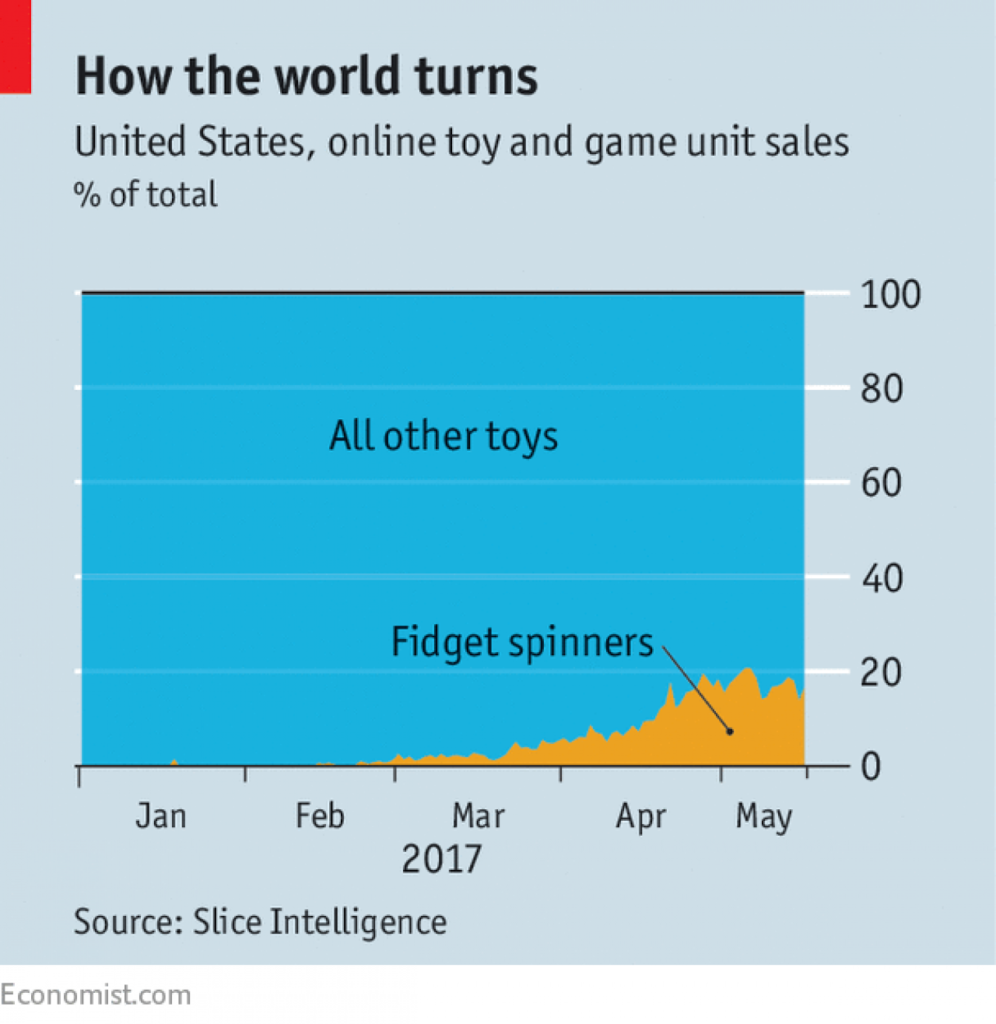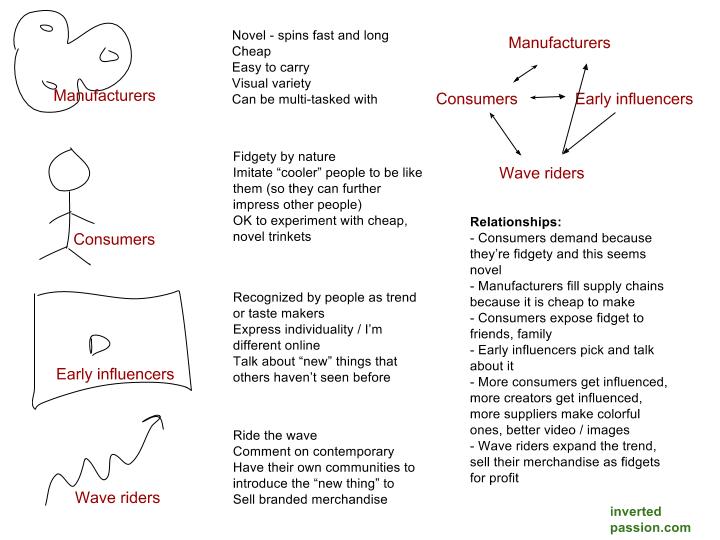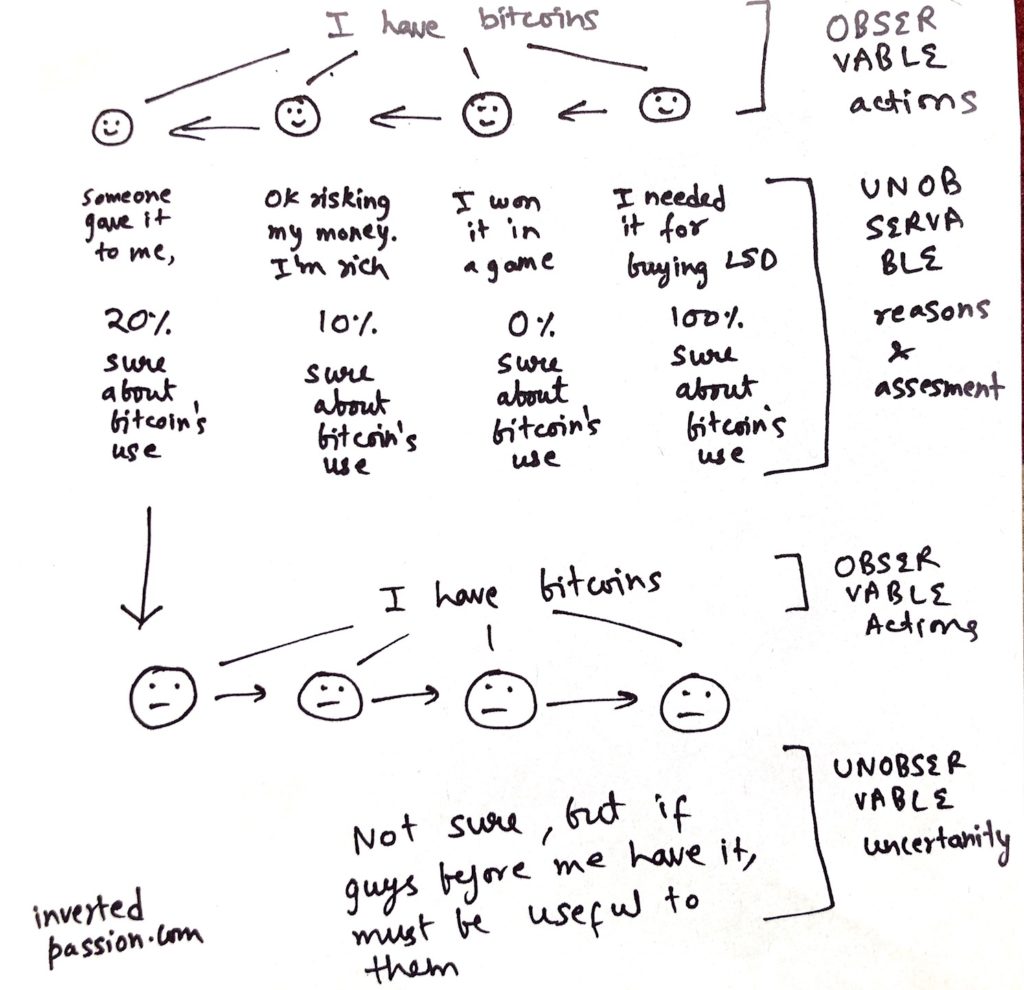Chances are that you know what fidget spinners are. I’m willing to take the risk of not linking to its Wikipedia page because I know almost everyone on the Internet either had one or seen one. (I had two!)
If you are a regular reader of InvertedPassion, you would know that I like going into rabbit holes. Previously, I wrote about Singapore’s foundation and lessons for entrepreneurs and also analyzed reasons for Facebook’s adoption in 2004 despite Myspace and Friendster having millions of users then. In this article, I’m spinning my way (no fun intended) into learning what made these little toys a global phenomenon and what entrepreneurs can learn to make their products grow like wildfire.
How big was the fidget spinners trend?
First, some facts to really understand the scale of success we’re talking about. In May 2017, all the top 20 toys on Amazon were either fidget spinners or fidget cubes. Some estimates put total sales of fidget spinners to be 200+ million units.

How did this happen?
The easy answer is that it was a fad, which it was but that doesn’t explain anything. Rather, it begs a follow-up question: what makes certain things a fad and not others?. Also, details matter: just like the winner-take-all effects are different for different networks (one tiny detail meant Facebook thrived while Friendster languished), all fads have details that make them different from each other. There’s value for entrepreneurs to understand how fidget spinners rose in popularity faster than any other toy, or why Minecraft is still popular but fidget spinners died out, or why many other more interesting toys failed to match fidget spinners’ success.
1st lesson: massive success is (usually) an alignment of incentives of multiple entities
The game of success is usually all about people and entities (including consumers) responding to incentives that they value. Magic happens when incentives of multiple different entities align. In case of fidget spinners, one detail mattered more than anything else: they were not patented. This non-requirement to license led tens of thousands of manufacturer make it without fear of getting sued. And that drove down the price significantly making fidget spinners affordable to everyone. Lack of patents was the reason price of fidget spinners came down from $100 (very first ones in the market) to a few dollars later. As the popular saying goes, the reason Windows became the de facto OS was because Microsoft was intentionally lax on pirated copies (even Bill Gates admits that).
I drew a systems diagram below that lists different entities that were involved in the fidget spinner story, their incentives and relationships between them. It’s one feedback loop after another.

Notice how things came together. Because it was so easy and cheap to make, Chinese manufacturers made it in hordes. And because the profit margins were enormous (cost is few cents and sales price is $10+), almost everyone who had imported something from China started importing and selling them. Because it was not patented, an entrepreneur didn’t need anyone’s permission to make or sell fidget spinners: students with debt, small-time toy companies, mobile repair shops, Walmarts, everyone who had retail space had fidget spinners to sell (what also helped was its smallness that made it easy to stock). Even celebrities jumped into the frenzy and make profit by launching their branded fidget spinners.
What’s interesting is that in this case, increased supply also contributed to increasing demand. Everyone who had a fidget spinner to sell was incentivized to market it whichever way they could. That’s how (later), fidget spinners kept getting exposed to a larger audience across the world.
This alignment of incentives has parallels in the B2B world too. Take Salesforce, for example. Salesforce is so complex that it mushroomed thousands of other service providers and partners who could earn money by configuring it. Their app store enabled thousands of other companies to extend its functionality. And all these service providers and developers implicitly and explicitly market Salesforce because their success is dependent on Salesforce’s success. Salesforce rise is partly explained by its well-aligned ecosystem.
2nd lesson: enable people to gain status among their friends or colleagues
People are in a never-ending pursuit to be better than their neighbors. This game of status is complex in structure: people want to blend in when it’s socially unacceptable to stand out (say, talk trash about religion, exhibiting near-insane behavior in public places, or marrying someone with the same sex). In these cases (which are plenty in our daily lives), we want to blend in with others. But, wherever and to whatever extent it’s socially acceptable, we also want to be seen different (cooler, prettier, smarter, wealthier, more discerning). Psychologists call it the conflict between independence and interdependence.
How things become socially acceptable is a topic of another post. Hint: it’s when masses observe few people not giving a damn by breaking social conventions; see torches of freedom.
For our analysis, it’s enough to understand that fidget spinners enabled early adopters to have one more way to be seen as different. Being different and hoping to impress others by our differentiated taste is a core desire that fidget spinners tapped into. And, satisfying our impulse to fidget helped too.
This impulse to impress friends is especially strong among kids who don’t a lot of other things with which to differentiate themselves. Cool toys and trinkets are Ferraris and Gucchis for young kids.
3rd lesson: make it worthy of making a video
Fidget spinner’s success was massively fueled by YouTube. So much so that if you play the video containing fidget spinners (like the one above), you’ll notice that the buffering loader changes to a fidget spinner. What contributed to Youtubers picking up fidget spinners and causing it to trend the sheer variety of colors, shapes, and sizes it came in. And this variety was possible because of its lack of patent – every one of the thousands of manufacturers gave fidget spinners its own little differentiation.
The lesson here is that variety makes it easier for a thing to spread because it allows users to express themselves and differentiate from others while taking part in a bigger phenomenon. It’s sort of like the rise of wine whereby you could talk with others about your love of wine but feel comfort in preserving your individuality by expressing how you like one particular type.
So, creating a video with your favorite or recommended fidget spinners is another way of playing the status game. What adds fuel to this trend is the recommendation and personalization algorithms. You see one fidget spinner video and Youtube recommends more fidget spinner videos to you, and more people watch such videos, more Youtube exposes such videos on the homepage. So, tiny early trends explode on Youtube (sometimes for no reason other than a string of good luck). In the case of fidget spinners, because creators could choose their favorite ones and do all sorts of new tricks, the volume of videos helped in picking up the trend.
Another example of videoworthiness making something popular is Minecraft. If you created a city in a game after days of work, you had to show it to someone. Everyone who uploaded a video about their creations was obviously promoting themselves, but the side-effect of it was Minecraft getting exposed to millions of other people.
In VWO, by prompting people to share their successful A/B test results with others, we tapped into this desire for higher status and made it easy for them to talk by making reports very visual. A 25% increase in CTR gets our users (well-deserved) respect from their colleagues and our reports, charts with screenshots of their website variations gave them raw material for their blog posts, case studies or videos.
Every time our users talked about how they increased their conversions, they mention VWO.

More examples of things that are videoworthy: advanced tricks in Excel, 10×10 rubik’s cube, and adult coloring books.
Obviously, not all products are videoworthy: some are boring, standardized or simply not cool enough to talk about. (These products are hard to find because nobody’s talking about them. They die a silent death).
4th lesson: Accept chance as success is contingent on early adoption
There’s an interesting theory by the name of ‘information cascade‘. The original paper (1992) is appropriately titled: A Theory of Fads, Fashion, Custom, and Cultural Change as Informational Cascades. The core idea is simple: if we see signals of the usefulness of a thing from others, we discount our own private assessment of it and make our decision to adopt or not adopt based on others’ adoption or non-adoption. This means that if I see everyone around me having fun with fidget spinners, my assessment of its funness is derived more from others’ assessments than my own. One quick reason for it is that we observe others’ actions and behaviors, but not reasons for those actions.

So while different people might have had fidget spinners (or bitcoin) for a variety of reasons (it came free, saw it somewhere, impulse purchase, strong recommendation, saw on youtube), what we observe is that everyone has it and (wrongly) deduce that they must be having it because it’s useful to them. Based on this, once we have it, the cascade continues as others observe us having those spinners and deducing that we bought it for a good reason (when in fact we had no clue!). In case of fidget spinners, they got lucky as they were picked by a community called The Everyday Things We Carry and information started cascading from there.
In information cascades, notice the difference between early adopter’s drive to stand out and late adopter’s drive to blend in. This has an interesting implication that for unpredictable reasons, a useful trend (like not selecting on college degrees while hiring candidates or vaccination) could fail to catch up because there are no early adopters (and if there are, they are doing it in private). Or that a fad (like pet rock) could start just because early adopters chose to adopt it for arbitrary reasons, and everyone else copied their behavior.
5th lesson: prevent it from dying out
Fidget spinners died faster than they rose. Information cascades and youtube trends that made it popular also eventually made it unpopular. The structure of small-world networks (like Youtube or Twitter) cause things to spread really fast in those networks. But the same structure also allows things to die down with the same (or faster) speed. (This is what makes me predict that Facebook, the product, will die out).

Just like businesses need to have moats to survive, fads need to keep evolving to find different ways to hold the interest of enough people to not let them die out. Of course, whether a fad dies out or not is unpredictable – the game Draw Something had replayability but died out. Uno, on the other hand, is a simple game with fixed rules but people still purchase it.
All hope is not lost though. What can help in sustaining a fad (but not guarantee it) is a feature or an aspect that’s malleable over time: barbies come in an infinite variety and always relevant to current times; Lego keeps on releasing new models, partnering with hit movies and becoming into movies; iPhone has new versions every two years; Playing cards can be used for a ton of games; Minecraft has new mods all the time.
Not many phenomena have the lasting power of something like religion, but even religion seems to be getting out of fashion globally. Core fans are striving to keep religion interesting and relevant to our times (via creationist debates, Christian rock, merchandise, latching onto existing trends, etc.) but for the same job, people are turning to other (less harmful) solutions.
Conclusion: putting it all together
In conclusion, what helped create fidget spinners a massive success is the following:
- Alignment of interests of consumers, manufacters, entrepreneurs, and influencers
- Tapping into existing desires of fidgeting, curiosity (how does it spin so long) and differentiating (I-have-something-cool-here)
- Infinite variety, colors, shapes and sizes making them videoworthy
- Being lucky to be picked up by early adopters in a tightly knit community
What have YOU been influenced by recently?
Now that you’ve read the article, I have a question for you.
What's a cool, new thing that you've recently bought or started using because your friend(s) had it?
I'll RT interesting responses.
— Paras Chopra (@paraschopra) January 17, 2018
Have you bought something recently that you came across via your friends? Tweet your response to me as a reply to this thread and I’ll retweet the most interesting examples. In the same thread, you can also check out and comment on what others proposed. Lots of interesting answers there.
Join 200k followers
Follow @paraschopra